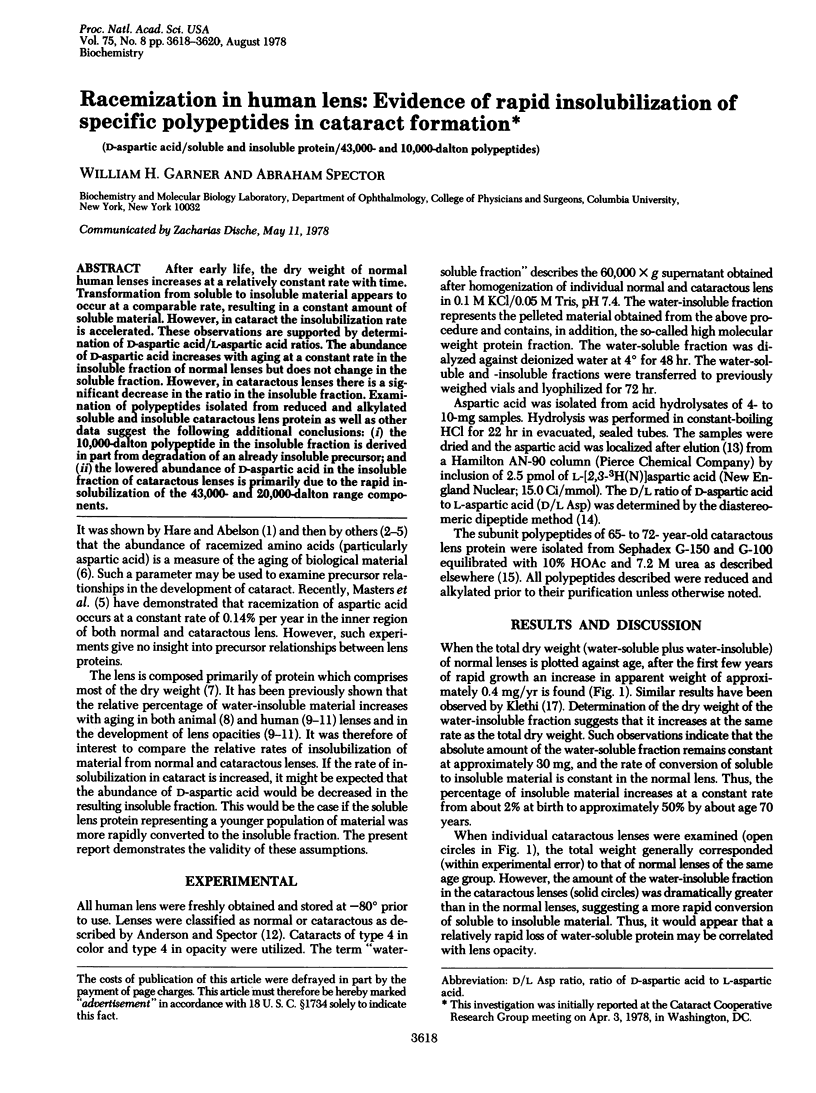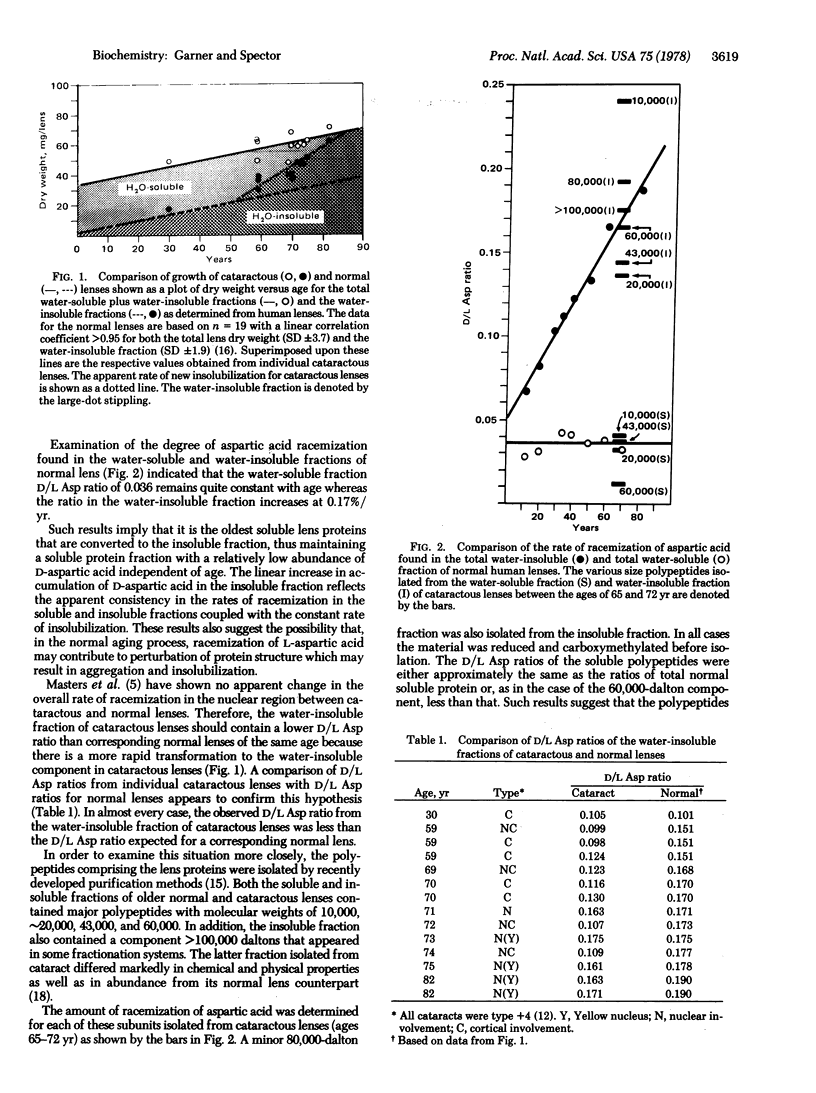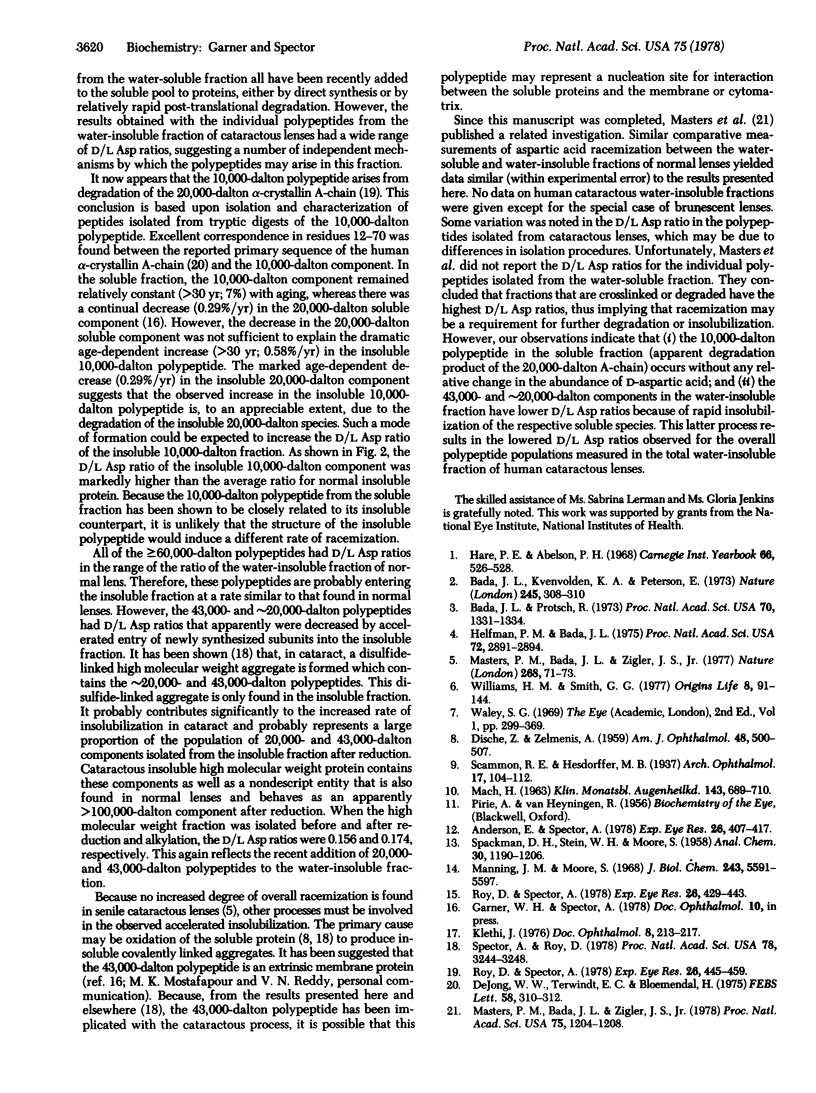Abstract
After early life, the dry weight of normal human lenses increases at a relatively constant rate with time. Transformation from soluble to insoluble material appears to occur at a comparable rate, resulting in a constant amount of soluble material. However, in cataract the insolubilization rate is accelerated. These observations are supported by determination of D-aspartic acid/L-aspartic acid ratios. The abundance of D-aspartic acid increases with aging at a constant rate in the insoluble fraction of normal lenses but does not change in the soluble fraction. However, in cataractous lenses there is a significant decrease in the ratio in the insoluble fraction. Examination of polypeptides isolated from reduced and alkylated soluble and insoluble cataractous lens proteins as well as other data suggest the following additional conclusions: (i) the 10,000-dalton polypeptide in the insoluble fraction is derived in part from degradation of an already insoluble precursor; and (ii) the lowered abundance of D-aspartic acid in the insoluble fraction of cataractous lenses is primarily due to the rapid insolubilization of the 43,000- and 20,000-dalton range components.
Full text
PDF


Images in this article
Selected References
These references are in PubMed. This may not be the complete list of references from this article.
- Anderson E. I., Spector A. The state of sulfhydryl groups in normal and cataractous human lens proteins. I. Nuclear region. Exp Eye Res. 1978 Apr;26(4):407–417. doi: 10.1016/0014-4835(78)90128-8. [DOI] [PubMed] [Google Scholar]
- Bada J. L., Protsch R. Racemization reaction of aspartic Acid and its use in dating fossil bones. Proc Natl Acad Sci U S A. 1973 May;70(5):1331–1334. doi: 10.1073/pnas.70.5.1331. [DOI] [PMC free article] [PubMed] [Google Scholar]
- DISCHE Z., ZELMENIS G. Nutritional and endocrine influences on the synthesis of albuminoid in rat lenses. I. The effect of restricted diet and L-thyroxine on the albuminoid formation. Am J Ophthalmol. 1959 Nov;48(5):500–507. [PubMed] [Google Scholar]
- Helfman P. M., Bada J. L. Aspartic acid racemization in tooth enamel from living humans. Proc Natl Acad Sci U S A. 1975 Aug;72(8):2891–2894. doi: 10.1073/pnas.72.8.2891. [DOI] [PMC free article] [PubMed] [Google Scholar]
- MACH H. UNTERSUCHUNGEN VON LINSENEIWEISS UND MIKROELEKTROPHORESE VON WASSERLOESLICHEM EIWEISS IM ALTERSSTAR. Klin Monbl Augenheilkd. 1963 Dec;143:689–710. [PubMed] [Google Scholar]
- Manning J. M., Moore S. Determination of D- and L-amino acids by ion exchange chromatography as L-D and L-L dipeptides. J Biol Chem. 1968 Nov 10;243(21):5591–5597. [PubMed] [Google Scholar]
- Masters P. M., Bada J. L., Zigler J. S., Jr Aspartic acid racemisation in the human lens during ageing and in cataract formation. Nature. 1977 Jul 7;268(5615):71–73. doi: 10.1038/268071a0. [DOI] [PubMed] [Google Scholar]
- Masters P. M., Bada J. L., Zigler J. S., Jr Aspartic acid racemization in heavy molecular weight crystallins and water insoluble protein from normal human lenses and cataracts. Proc Natl Acad Sci U S A. 1978 Mar;75(3):1204–1208. doi: 10.1073/pnas.75.3.1204. [DOI] [PMC free article] [PubMed] [Google Scholar]
- Roy D., Spector A. Human insoluble lens protein. I. Separation and partial characterization of polypeptides. Exp Eye Res. 1978 Apr;26(4):429–443. doi: 10.1016/0014-4835(78)90130-6. [DOI] [PubMed] [Google Scholar]
- Roy D., Spector A. Human insoluble lens protein. II. Isolation and characterization of a 9600 dalton polypeptide. Exp Eye Res. 1978 Apr;26(4):445–459. doi: 10.1016/0014-4835(78)90131-8. [DOI] [PubMed] [Google Scholar]
- Spector A., Roy D. Disulfide-linked high molecular weight protein associated with human cataract. Proc Natl Acad Sci U S A. 1978 Jul;75(7):3244–3248. doi: 10.1073/pnas.75.7.3244. [DOI] [PMC free article] [PubMed] [Google Scholar]
- Williams K. M., Smith G. G. A critical evaluation of the application of amino acid racemization to geochronology and geothermometry. Orig Life. 1977 Aug;8(2):91–144. doi: 10.1007/BF00927978. [DOI] [PubMed] [Google Scholar]
- de Jong W. W., Terwindt E. C., Bloemendal H. The amino acid sequence of the A chain of human alpha-crystallin. FEBS Lett. 1975 Oct 15;58(1):310–313. doi: 10.1016/0014-5793(75)80286-9. [DOI] [PubMed] [Google Scholar]



